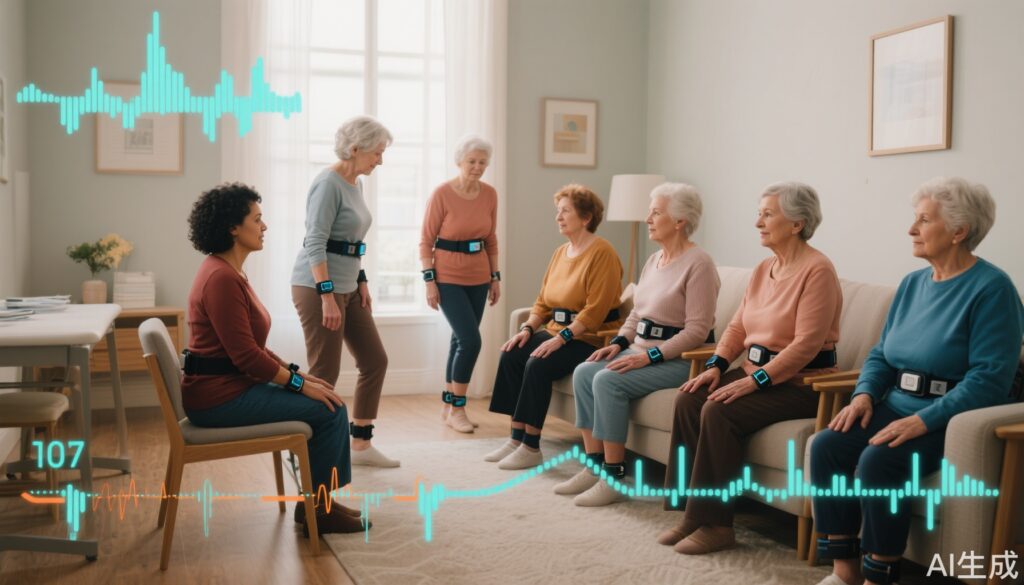Highlight
– A 12-week randomized controlled trial (RCT) demonstrates that increasing daily sit-to-stand transitions (STSTs) modestly but significantly lowers diastolic blood pressure in sedentary, overweight or obese postmenopausal women.
– Neither reducing overall sitting time nor increasing STSTs led to meaningful changes in glucose regulation markers over the study period.
– Interventions focusing on breaking up sedentary time with simple postural changes may offer a pragmatic approach to lower cardiovascular risk in this high-risk population.
Background
Sedentary behavior is increasingly recognized as an independent cardiovascular risk factor, particularly among older adults and postmenopausal women. Prolonged sitting is associated with increased risks of hypertension, type 2 diabetes, and all-cause mortality, even after adjusting for moderate-to-vigorous physical activity. Postmenopausal women, especially those with overweight or obesity, face compounded risks due to metabolic changes, decreased estrogen, and a propensity for higher sedentary time. Despite extensive public health messaging on physical activity, practical, scalable interventions to reduce sedentary time and improve cardiometabolic outcomes in this group remain an unmet need.
Study Overview and Methodological Design
Hartman and colleagues conducted a three-arm RCT (Circulation, 2025) to examine the effects of two sedentary behavior reduction strategies—overall sitting time reduction versus increasing sit-to-stand transitions—on blood pressure and glucose regulation in postmenopausal women with overweight or obesity.
– Participants: 407 postmenopausal women (mean age 68 years, 92% White) with BMI ≥25 kg/m² (mean 32), self-reported sitting ≥7 hours/day, and ≤70 STSTs daily.
– Randomization: Participants were assigned to one of three arms:
– Healthy living (control; n=135): Received standard health coaching.
– Sit less (n=136): Targeted reduction in total sitting time.
– Increased sit-to-stand (n=136): Targeted increase in daily STSTs.
– Intervention: All arms received seven individual health coaching sessions over 12 weeks. Objective measurement of sedentary behavior and activity was captured using thigh- and hip-worn accelerometers for 7 days at baseline and study end.
– Primary Outcomes: Changes in markers of glucose regulation (from fasting blood samples) and resting blood pressure at 3 months.
– Secondary Outcomes: Accelerometer-based changes in sitting time, STSTs, and adverse event monitoring.
Table 1. Participant Baseline Characteristics Overall and by Randomized Arm (n=407)
| Overall | Healthy living | Sit less | Sit-to-stand | P* | |
|---|---|---|---|---|---|
| n | 407 | 135 | 136 | 136 | |
| Age, mean (SD) | 67.81 (7.23) | 67.76 (7.43) | 68.39 (7.66) | 67.29 (6.55) | 0.45 |
| BMI (mean (SD)) | 32.13 (4.93) | 32.33 (5.13) | 32.00 (4.64) | 32.06 (5.06) | 0.85 |
| Race (%) | 0.87 | ||||
| White | 371 (92.1) | 120 (90.2) | 126 (94.0) | 125 (91.9) | |
| Black or African-American | 15 (3.7) | 7 (5.3) | 4 (3.0) | 4 (2.9) | |
| Asian | 10 (2.5) | 3 (2.3) | 2 (1.5) | 5 (3.7) | |
| American Indian/Alaskan Native | 2 (0.5) | 1 (0.8) | 0 (0.0) | 1 (0.7) | |
| >1 race | 5 (1.2) | 2 (1.5) | 2 (1.5) | 1 (0.7) | |
| Latina/Hispanic (%) | 35 (8.6) | 12 (8.9) | 13 (9.6) | 10 (7.5) | 0.82 |
| Employed full-time (%) | 101 (24.8) | 32 (23.7) | 34 (25.0) | 35 (25.7) | 0.93 |
| Education (%) | 0.58 | ||||
| High school diploma or less | 113 (27.8) | 33 (24.4) | 43 (31.6) | 37 (27.2) | |
| College degree | 99 (24.3) | 38 (28.1) | 28 (20.6) | 33 (24.3) | |
| Graduate degree | 195 (47.9) | 64 (47.4) | 65 (47.8) | 66 (48.5) | |
| Have arthritis (%) | 232 (57.0) | 75 (55.6) | 81 (59.6) | 76 (55.9) | 0.76 |
| Have hypertension (%) | 201 (49.4) | 68 (50.4) | 72 (52.9) | 61 (44.9) | 0.40 |
| Currently taking hypertension medication, of those with hypertension (%) | 163 (81.1) | 54 (79.4) | 60 (83.3) | 49 (80.3) | 0.83 |
| Have diabetes (%) | 35 (8.6) | 18 (13.3) | 11 (8.1) | 6 (4.4) | 0.03 |
| Currently taking diabetes medication, of those with diabetes (%) | 24 (68.6) | 14 (77.8) | 8 (72.7) | 2 (33.3) | 0.19 |
| Number of falls in the past year (%) | 0.43 | ||||
| 0 | 260 (63.9) | 83 (61.5) | 92 (67.6) | 85 (62.5) | |
| 1 | 99 (24.3) | 38 (28.1) | 26 (19.1) | 35 (25.7) | |
| 2 | 38 (9.3) | 9 (6.7) | 15 (11.0) | 14 (10.3) | |
| ≥3 | 10 (2.5) | 5 (3.7) | 3 (2.2) | 2 (1.5) | |
Key Findings
 Figure 2. Baseline and 3-month values by study arm. Minutes per day of sitting time (A), number of sit-to-stand transitions per day (B), minutes standing per day (C), and minutes of moderate to vigorous physical activity (MVPA) per day (D).
Figure 2. Baseline and 3-month values by study arm. Minutes per day of sitting time (A), number of sit-to-stand transitions per day (B), minutes standing per day (C), and minutes of moderate to vigorous physical activity (MVPA) per day (D).
– Completion: 388 of 407 participants completed the trial. No serious adverse events related to the intervention were reported.
– Behavioral Change:
– The sit-less group reduced daily sitting time by approximately 58 minutes compared with controls (P < .001).
– The sit-to-stand group increased daily transitions by 26 more than controls (P < .001).
– Blood Pressure:
– Diastolic blood pressure decreased by 2.24 mm Hg in the sit-to-stand group relative to controls (P = .02).
– The reduction in systolic blood pressure did not reach statistical significance.
– Glucose Regulation:
– Neither intervention produced significant changes in fasting glucose or insulin markers compared with the healthy-living arm.
| Group | Sitting Time Change (min) | STST Change (per day) | Δ Diastolic BP (mm Hg) | Δ Systolic BP (mm Hg) |
|---|---|---|---|---|
| Healthy Living | — | — | — | — |
| Sit Less | -58 | Not significant | Not significant | Not significant |
| Sit-to-Stand | Not significant | +26 | -2.24 (P=0.02) | Not significant |
Mechanistic Insights and Pathophysiological Context
The observed reduction in diastolic blood pressure with increased STSTs likely reflects the physiological benefits of interrupting prolonged sitting, which is associated with venous pooling, reduced shear stress, and transient decreases in lower-limb muscle contractile activity. Brief, frequent postural changes may stimulate endothelial function, promote venous return, and reduce arterial stiffness—factors implicated in the regulation of diastolic pressure. While more pronounced or prolonged interventions may be required to affect glucose homeostasis, these findings align with evidence that even light-intensity activity can confer vascular benefits, particularly in populations with impaired vascular reactivity such as postmenopausal women.
Clinical Implications
From a practical perspective, encouraging frequent STSTs represents a low-barrier, scalable strategy to reduce cardiovascular risk in a demographic that may face challenges engaging in sustained moderate-to-vigorous physical activity. The diastolic blood pressure reduction, though modest, is clinically meaningful given the population’s baseline risk and the intervention’s simplicity. Importantly, this approach can be integrated into daily routines (e.g., standing up during television breaks or phone calls), potentially complementing other lifestyle interventions targeting diet and exercise.
For primary care and cardiometabolic clinics, these findings support adding specific advice on breaking up sitting time with STSTs to routine counseling for postmenopausal women, especially those with overweight or obesity.
Limitations and Controversies
Several limitations warrant consideration:
– The study population was predominantly White, limiting generalizability to more diverse populations.
– The intervention duration (12 weeks) may have been insufficient to elicit changes in glucose regulation or more robust blood pressure effects.
– The magnitude of blood pressure reduction, while statistically significant for diastolic measurements, was relatively small, and systolic blood pressure changes were not significant.
– Accelerometer adherence and measurement accuracy may influence observed behavioral changes.
– Further research is needed to determine the sustainability of behavior change and its effects on hard cardiovascular endpoints (e.g., myocardial infarction, stroke).
Expert Commentary or Guideline Positioning
Current clinical guidelines from the American Heart Association and American College of Cardiology emphasize regular physical activity and minimizing sedentary time as part of comprehensive cardiovascular risk reduction (Arnett DK et al., 2019). While specific recommendations on STST frequency are not yet standard, this trial adds to the growing evidence base supporting simple, actionable approaches for sedentary adults. As the researchers conclude, “within just 3 months, increasing STSTs can lower diastolic blood pressure,” highlighting the value of even minor behavioral modifications.
Conclusion
This RCT provides clinically relevant evidence that increasing daily sit-to-stand transitions can lower diastolic blood pressure in sedentary, overweight or obese postmenopausal women. Although effects on glucose regulation were not observed, the intervention’s safety, feasibility, and potential for scalable cardiovascular risk reduction are notable. Future research should assess long-term adherence, effects in more diverse populations, and the impact on major cardiovascular outcomes. For now, clinicians can consider advocating for more frequent postural changes as part of holistic risk reduction in this vulnerable demographic.
References
1. Hartman SJ, LaCroix AZ, Sears DD, Natarajan L, Zablocki RW, Chen R, Patterson JS, Dillon L, Sallis JF, Schenk S, Dunstan DW, Owen N, Rosenberg DE. Impacts of Reducing Sitting Time or Increasing Sit-to-Stand Transitions on Blood Pressure and Glucose Regulation in Postmenopausal Women: Three-Arm Randomized Controlled Trial. Circulation. 2025 Jul 25. doi: 10.1161/CIRCULATIONAHA.124.073385 IF: 38.6 Q1 . Epub ahead of print. PMID: 40709462 IF: 38.6 Q1 .
2. Arnett DK, Blumenthal RS, Albert MA, et al. 2019 ACC/AHA Guideline on the Primary Prevention of Cardiovascular Disease: A Report of the American College of Cardiology/American Heart Association Task Force on Clinical Practice Guidelines. Circulation. 2019;140(11):e596–e646. doi:10.1161/CIR.0000000000000678 IF: 38.6 Q1 .


